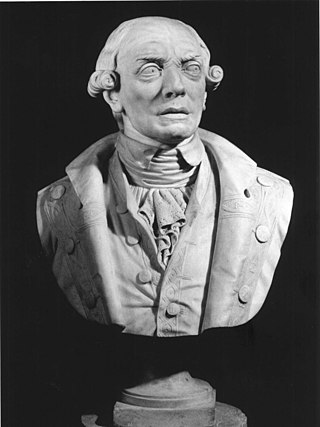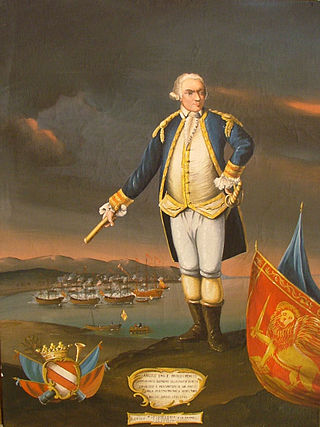Related Research Articles

The Battle of Lepanto was a naval engagement that took place on 7 October 1571 when a fleet of the Holy League, a coalition of Catholic states arranged by Pope Pius V, inflicted a major defeat on the fleet of the Ottoman Empire in the Gulf of Patras. The Ottoman forces were sailing westward from their naval station in Lepanto when they met the fleet of the Holy League which was sailing east from Messina, Sicily.

The Action of 8 July 1716 was an indecisive naval battle that took place on 8 July 1716 during a Turkish attempt to capture the island of Corfu (Kerkyra), off the west coast of mainland Greece.

The naval Battle of Zonchio took place on four separate days: 12, 20, 22, and 25 August 1499. It was a part of the Ottoman–Venetian War of 1499–1503.

Angelo Emo was a Venetian noble, administrator, and admiral. He is notable for his reforms of the Venetian navy and his naval campaigns, being regarded as the last great admiral of the Venetian Republic.

The Second Ottoman–Venetian War was fought from 1499 to 1503 between the Ottoman Empire and the Republic of Venice for control of contested lands in the Aegean Sea, the Ionian Sea and the Adriatic Sea.

Lorenzo Marcello was a Venetian admiral.

The siege of Corfu took place on 8 July – 21 August 1716, when the Ottoman Empire besieged the city of Corfu, on the namesake island, then held by the Republic of Venice. The siege was part of the Seventh Ottoman–Venetian War, and, coming in the aftermath of the lightning conquest of the Morea by the Ottoman forces in the previous year, was a major success for Venice, representing its last major military success and allowing it to preserve its rule over the Ionian Islands.

The Venetian navy was the navy of the Venetian Republic which played an important role in the history of the republic and the Mediterranean world. It was the premier navy in the Mediterranean Sea for many centuries between the medieval and early modern periods, providing Venice with control and influence over trade and politics far in excess of the republic's size and population. It was one of the first navies to mount gunpowder weapons aboard ships, and through an organised system of naval dockyards, armouries and chandlers was able to continually keep ships at sea and rapidly replace losses. The Venetian Arsenal was one of the greatest concentrations of industrial capacity prior to the Industrial Revolution and responsible for the bulk of the republic's naval power.

The Battle of Gallipoli occurred on 29 May 1416 between the fleets of the Republic of Venice and the Ottoman Empire off the port city of Gallipoli, the main Ottoman naval base. The battle was the main episode of a brief conflict between the two powers, resulting from Ottoman attacks against possessions and shipping of the Venetians and their allies in the Aegean Sea in 1414–1415. The Venetian fleet, under Pietro Loredan, was charged with transporting a Venetian embassy to the Ottoman sultan, but was authorized to attack if the Ottomans refused to negotiate. The subsequent events are known chiefly from a detailed letter written by Loredan after the battle.
Tommaso Condulmer was a Venetian naval officer and nobleman. After the death of Angelo Emo he took command of the Venetian navy, and held major responsibilities in the aborted defense of Venice against Napoleon's forces which eventually led to the fall of the Republic of Venice in 1797.
Alvise Loredan was a Venetian nobleman of the Loredan family. At a young age he became a galley captain, and served with distinction as a military commander, with a long record of battles against the Ottomans, from the naval expeditions to aid Thessalonica, to the Crusade of Varna, and the opening stages of the Ottoman–Venetian War of 1463–1479, as well as the Wars in Lombardy against the Duchy of Milan. He also served in a number of high government positions, as provincial governor, savio del consiglio, and Procuratore de Supra of Saint Mark's Basilica.

The Captain General of the Sea was the wartime commander-in-chief of the Venetian navy.
The Captain of the Gulf was a senior naval command of the Republic of Venice.

The Battle of Trapani took place on 23 June 1266 off Trapani, Sicily, between the fleets of the Republic of Genoa and the Republic of Venice, as part of the War of Saint Sabas (1256–1270). During the war, the Venetians held the upper hand in naval confrontations, forcing the Genoese to resort to commerce raiding and avoiding fleet battles. In the 1266 campaign, the Genoese had an advantage in numbers, but this was not known to the Genoese commander, Lanfranco Borbonino. As a result, the Genoese tarried at Corsica until the end of May. The Venetian fleet under Jacopo Dondulo, was left to sail back and forth awaiting the appearance of the Genoese fleet in the waters around southern Italy and Sicily. Fearing that the other side had more ships, both sides reinforced their fleets with additional ships, but the Genoese retained a small numerical advantage.
The governatore dei condannati was a senior commander of the navy of the Republic of Venice. The post initially headed the galley squadron manned by convicts and captives rather than free crewmen.
The Capitano delle Navi was a senior commander of the ships of the line of the navy of the Republic of Venice.

The Capitano Straordinario delle Navi was the senior wartime commander of the ships of the line of the navy of the Republic of Venice.

The Provveditore all'Armata or dell'Armata or d'Armata was a senior official and admiral of the Venetian navy. After the establishment of a sailing fleet next to the traditional galley fleet in the late 17th century, he was the most senior squadron admiral of the latter.
The Provveditori all'Armar were officials of the Republic of Venice responsible for the provisioning and equipment of the ships and crews of the Venetian navy.
The Patron delle Navi, also Patrono or Patrona delle Navi, was a squadron commander of the ships of the line of the navy of the Republic of Venice.
References
- 1 2 3 4 5 Mocenigo 1935, p. 24.
- 1 2 3 Lane 1973, p. 158.
- ↑ Mocenigo 1935, p. 3.
- 1 2 Mocenigo 1935, p. 25.
- ↑ Mocenigo 1935, pp. 25–26.
- ↑ Mocenigo 1935, pp. 24, 27.
- ↑ Lane 1973, p. 159.
- ↑ Lane 1982, p. 28.
- ↑ Lane 1982, pp. 28–29.
- ↑ Lane 1982, pp. 27–30.
- ↑ Mocenigo 1935, pp. 25, 26.
- 1 2 Mocenigo 1935, p. 26.
- ↑ Mocenigo 1935, pp. 24–25.
- ↑ Mocenigo 1935, p. 4.
